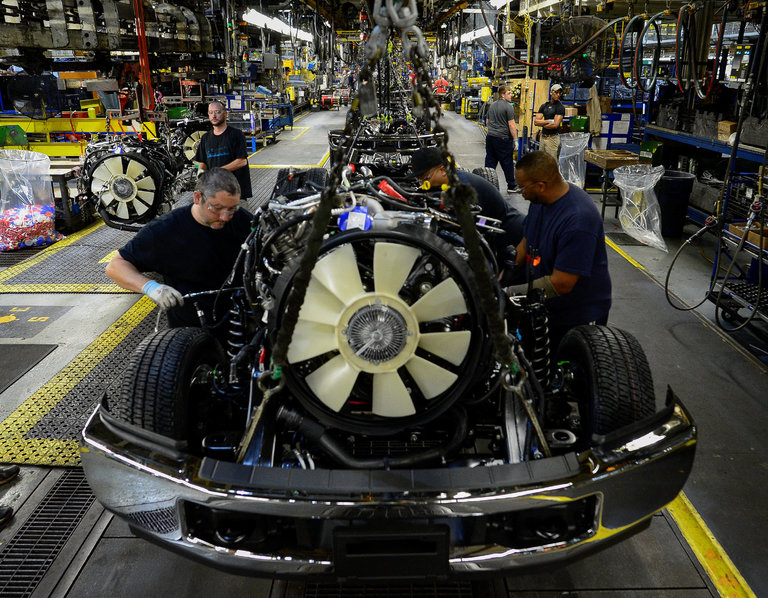
Most of the time, the release of monthly employment numbers is important because the figures tell us something about Americans’ prospects for finding a job, whether the economy is slowing down or speeding up, and perhaps what the Federal Reserve is likely to do at coming meetings.
But with the election a month away, the jobs report takes on extra significance, as a piece of major economic news that might shape how people vote for president. So looking at the data through a political lens makes perfect sense.
And the new results — that the unemployment rate ticked up to 5 percent as the nation added 156,000 jobs in September — point to an economy that is on a steady course. The numbers are good enough that Hillary Clinton can argue that the economy continues to improve: The number of people in the labor force rose by 444,000, a good sign that some of the people who left the job market in recent years have returned. Average hourly wages are up a solid 2.6 percent over a year ago.
Yet the results are still soft enough that Donald J. Trump has plenty of ground for attack on the state of the economy as the Obama administration nears its end: There is that uptick in the unemployment rate, the 156,000 jobs added are no great shakes, a broader measure of unemployment remains at 9.7 percent, and the ratio of Americans working remains significantly lower than eight years ago.
Advertisement
Continue reading the main story
But while it’s easy enough to tick through the bullish and bearish case on the state of the economy, what’s particularly striking is how little this election has focused on the economy — or at least the cyclical state of it. Consider this: In the first presidential debate, the word “unemployment” was not mentioned once. By contrast, in the first 2012 debate between President Obama and Mitt Romney, Mr. Romney assailed the president for what his health plan would do to jobs and on the continued high jobless rate at that time.
One reason is probably that President Obama is not on the ballot, and so debating his economic record is less relevant. But the bigger one is surely that the state of the economy isn’t really the focus of this race because the economy is largely, finally, healed from the 2008 recession. Consider that the 5 percent September unemployment rate is the second lowest for a September before a presidential election in nearly five decades. Since the 1968 election, only the 2000 race featured a lower pre-election jobless rate.
Unemployment and Elections: The Recent Track Record
The September jobless rate is the second lowest at this point in a presidential election cycle in recent decades.
Much of what people frame as a debate over “the economy” in the 2016 election cycle is not about the cyclical state of the economy, which was a first-order issue in 2008, 2012 and, to some degree, 2004. Rather, it is about long-simmering shifts, some of which are barely about economics at all.
Sure, slow-growing wages for middle- and working-class Americans have been an underlying fact going back decades, and there is surely an economic dimension to polling data that shows many people believe America’s best days are in the past.
But there’s evidence that much of the atmosphere of economic discontent right now isn’t really about economics in a narrow sense — or at least not the way technocrats usually view it. As the former Fed chairman Ben Bernanke has observed, there is an odd disconnect in polling lately. When people are asked about their personal finances, and whether they are improving or worsening, people are as happy as they have been in many years.
In other words, the evidence we see in things like the new jobs report, that unemployment is low and wages are rising — fits what people see in their own lives.
But when asked about, as Gallup does, “the way things are going” more broadly, the results are much more negative. It seems that when asked about how things are going over all, Americans aren’t really making an observation about their personal financial situation, but more a stylized observation about whether they are optimistic or pessimistic about the state of the world. The Trump phenomenon seems to be driven by that pessimistic impulse.
Because Election Day falls on the late end this year, there will be one more jobs report the Friday before the Nov. 8 voting, along with a second-quarter G.D.P. report and a Fed policy meeting. But this is the last big economic headline to take place before early voting begins most places, and the conditions that will shape voters’ perception of the state of the world are pretty well baked into the economic cake by now.
Yet the evidence suggests that, whether those announcements point to good news or bad, they won’t matter much in shaping how people think about the world heading into the voting booth.
Continue reading the main story
Article source: http://www.nytimes.com/2016/10/08/upshot/looking-at-the-jobs-report-through-a-political-lens.html?partner=rss&emc=rss
Speak Your Mind
You must be logged in to post a comment.